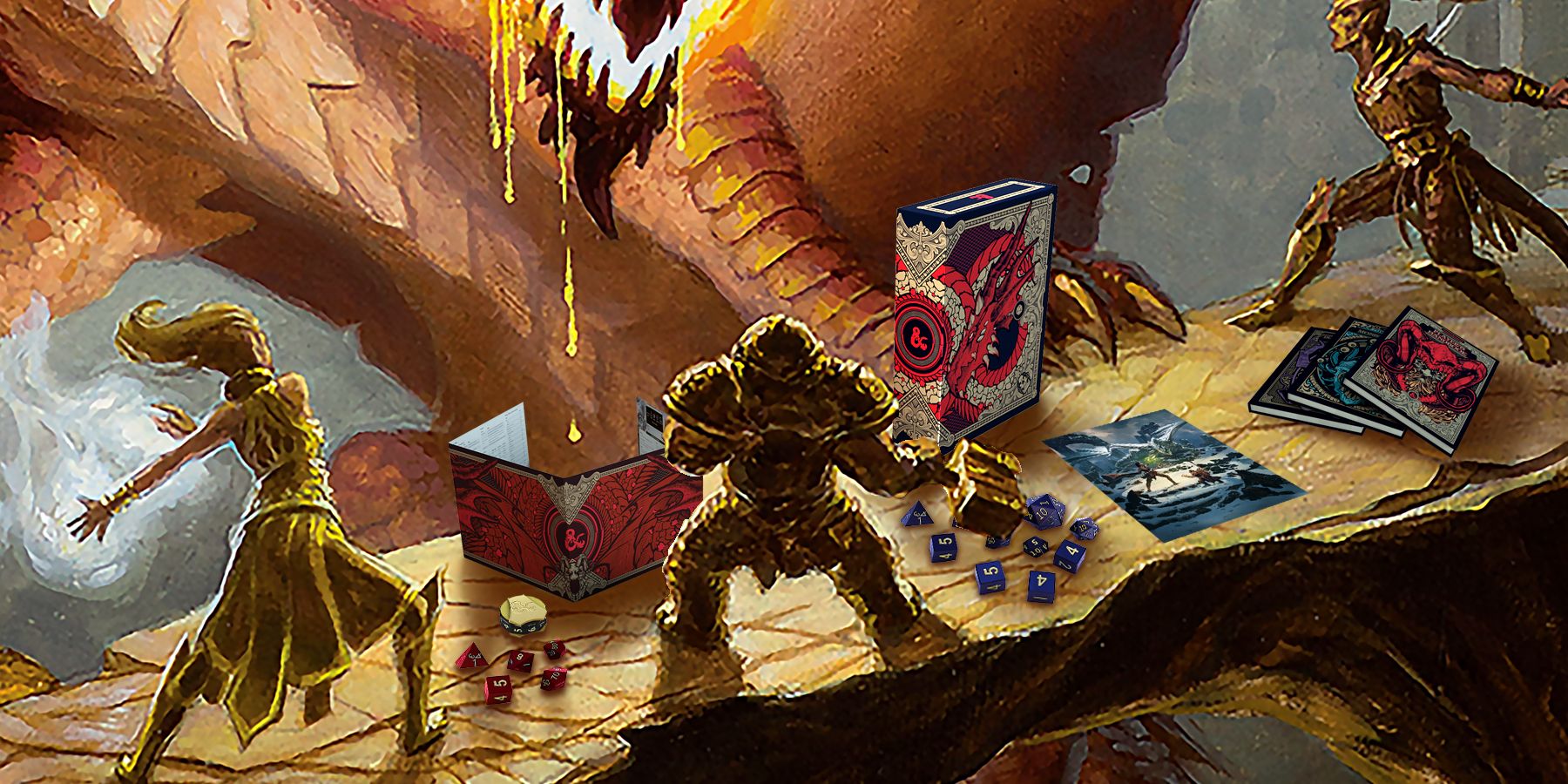Highlights
- Extended Spell: Sorcerers can double the duration of spells up to 24 hours, but should only be used on spells that last for at least a few hours.
- Distant Spell: Sorcerers can double the range of spells, but it's most useful for touch-based spells or low-level spells that need more range.
- Subtle Spell: Sorcerers can cast spells without gestures or words, useful for stealth encounters or when casting spells in public.
The Sorcerer in Dungeons & Dragons goes toe-to-toe against the Wizard in terms of flexibility. After all, while the D&D Wizard collects tome after tome of useful spells, the Sorcerer can manipulate the nature of magic itself. Moreover, it's the Sorcerer's Metamagic feature that transforms it into one of the most versatile classes in the D&D canon.

Best Dungeons & Dragons Video Games, Ranked
RPGs and similar genres in the video game world owe their existence to Dungeons & Dragons, and these games embody the franchise well.
Metamagic allows Sorcerers to transform the simplest of Spells into the heaviest of bulldozers in combat. For instance, Metamagic allows Spells to have multiple targets, faster casting, and even less cost in terms of resources. However, which Metamagic options should Sorcerers give more attention to? Which Metamagic options should Sorcerers just ignore?
Updated January 31, 2024 by Rhenn Taguiam: With Dungeons & Dragons 5th Edition celebrating its 10th Anniversary alongside releasing a new Player’s Handbook, players who want to make powerhouse builds may want to consider the raw power of the Sorcerer and its unique Metamagic mechanics.
Unlike other Spellcasters, Sorcerers can imbue special properties to Spells to make them much stronger assets in combat. And while all Sorcerers can technically tap into all available Metamagic Options, certain Metamagic abilities stand out when used by particular Sorcerous Origins with their specialized Spells. However, just how would specific Sorcerous Origins maximize their Metamagic capabilities?
10 Extended Spell
Extend The Efficiency Of A Spell
Sorcery Point, Action Cost | 1 Sorcery Point, Casting a Spell |
|---|---|
Effect | Boost the duration of a Spell that lasts from 1 Minute to last 24 Hours |
Spells usually only have a limited timetable to remain potent. But if a Sorcerer casts a Spell that will last for at least a minute, they can use Extended Spell to double its duration. Sorcerers can spend one Sorcery Point to double the duration of said Spells up to a whopping 24 hours.
Unfortunately, despite the potential of such a Metamagic Option, not all Spells in D&D need that prolonged timetable. Remember, extending most Spells will have them last an entire fight. Thus, players should only use Extended Spell on Spells that last for at least a few hours. This Metamagic Option might work best when Sorcerers work in tandem with the versatile Ranger when stalking their prey, who has run off to a nearby village or city.
Example Uses Of Extended Spell
While its duration extension isn’t always as helpful, Extended Spell can give certain Spells enough boost to aid in terms of Spell Slot Economy. Thus, it sees the most uses in Spells that could use the extension to avoid having to reuse Spell Slots.
Extending a Spell for up to 24 hours could make Spells boost efficiency for longer periods, although the usefulness of such an effect depends on the situation. Traditional Extended Spell examples may include:
- Aura of Vitality (3rd-Level Evocation): A Bonus Action allows its caster to heal a target for 2d6 HP, making it usable for 20d6 or 10 tries in a minute. Doubling its duration or even making it last until the party takes a Long Rest could extend its healing capabilities out of combat.
- Darkvision (2nd-Level Transmutation): Granting Darkvision to a person for 8 hours should last them an encounter or two, but extended dungeoneering could benefit from a 16-hour Darkvision buff.
Works Well With Aberrant Mind
A Sorcerer whose raw magical prowess comes from an external psionic influence may be considered an Aberrant Mind, giving them access to more thematic mind-themed abilities that encapsulate their capacity to influence their minds and those of others. Interestingly enough, much of the game’s Enchantment, Divination, Illusion, and even Transmutation Spells have similar effects, making them ideal utility Spells to use to fit the aesthetic of the psionic Sorcerer. With Extended Spell, players can boost the Aberrant Mind’s utility potential even further, ensuring that Spells that last for at least a minute may last for an entire day - spelling the difference between a well-timed illusion or a hyper-efficient effect.
9 Distant Spell
Affect Further Targets With Spells
Sorcery Point, Action Cost | 1 Sorcery Point, Casting a Spell |
|---|---|
Effect | Double the range of the Spell cast, provided it has a range of at least 5 Feet. If range is Touch, it extends to 30 feet |
Even the most useful Spells become useless if they can't hit their targets. Thanks to Distant Spell, Sorcerers can imbue Spells with double their respective range. For instance, Sorcerers can spend a Sorcery Point to extend the range of touch-based spells of up to 30ft, while Spells with at least 5ft range can have double the range.
Unfortunately, despite the usefulness of the Metamagic Option, most Spells already have a reasonable range of efficacy. Moreover, Spells with useful ranges such as cone-based attacks won't benefit from Distant Spell as they have a range of "Self," which does not qualify under Distant Spell.
Example Uses Of Distant Spell
While distance isn’t always a factor for a Spellcaster’s potency, Distant Spell can transform a Spell into a pure nightmare in the right situation. A Sorcerer can safely cast touch-based Spells as far as 30 feet. Likewise, this can extend the range of a low-level Spell without having to expend a higher-level Spell Slot.
Touch-based Spells benefit the most from being Distanced, especially since long-ranged Spells that don’t reach their targets will likely have said targets move closer to attack the party’s casters anyway.
- Buffs: Touch-based buffs (e.g., Guidance, Light, Resistance, Mage Armor) could be Distanced to affect nearby allies without necessarily having to be close to the caster.
- Heals: Recovery spells that only affect via touch (e.g., Cure Wounds) can become more useful in case of emergencies.
Works Well With Mage Of Prismari
Accessed via Unearthed Arcana #79: Mages of Strixhaven, players who are also fans of Magic: The Gathering may want to tap into their character’s inner creativity as fuel to their magic. As a Mage of Prismari, a Sorcerer may be able to use Favored Medim and Focused Expression to inflict additional effects on targets affected by Cold, Fire, and Lightning Spells. With Distant Spell, a Mage of Prismari can extend the effects of Focused Expression towards many further targets, allowing them to cast Spells from a safe distance without risking exposure.
8 Subtle Spell
Make Spellcasting Quieter And Less Obtrusive
Sorcery Point, Action Cost | 1 Sorcery Point, Casting a Spell |
|---|---|
Effect | Cast a Spell without using Somatic or Verbal Components |
Spellcasters know that all Spells require different components – somatic or gestures and verbal or words, to name a few. With Subtle Spell, Sorcerers can cast a Spell without having to make gestures or speak words. Technically speaking, doing this maneuver only costs a Sorcery Point. This should all be good, right?
This might not be the most helpful option for Sorcerers. For instance, most combat scenarios won't need Sorcerers to take note of who sees them cast their Spells. However, Subtle Spell does work in scenarios where casting Spells in public or during stealth missions while finding an artifact can cause problems. Unfortunately, the scenario-based nature of this Metamagic Option doesn't make it the most ideal option for Sorcerers.
Example Uses Of Subtle Spell
However, utility Sorcerers will love Subtle Spell for its sheer practical application. Spellcasters that rely on illusions can completely hide their Spellcasting with Subtle Spell. Bypassing the need for Somatic and Verbal Components for spellcasting makes Subtle Spell perfect for stealth encounters and emergencies.
- Mobility Spells: Any mobility-inclined Spell (e.g., Blink, Blur, Dimension Door, Misty Step) benefits from being Subtled, especially when Grappled or in danger.
- Illusion/Enchantment Spells: Any Spell that creates illusions or enchants a target becomes unrecognizable when cast silently.
Works Well With Stone Sorcery
Accessed via Unearthed Arcana #28: Sorcerer, a Spellcaster whose Sorcerous Origins have ties to the very earth they walk on can be considered a user of Stone Sorcery. In terms of the game’s mechanics, a Stone Sorcerer has access to Metal Magic that gives them options to use special weapon attacks as Spells. Such Spells include Smites (Searing, Thunderous, Wrathful, Branding, Blinding, Staggering) as well as combat-oriented Spells like Compelled Duel, Magic Weapon, and Elemental Weapon. Subtle Spell being able to skip the need for Somatic Components (movement) can work well with Metal Magic.
7 Seeking Spell
Reroute A Spell That Misses The Mark
Sorcery Point, Action Cost | 2 Sorcery Point, Spell Attack Roll (Player) |
|---|---|
Effect | Players who miss a Spell Attack Roll can reroll the d20 and use the new roll |
Despite the powerful nature of some Spells, certain spellcasters just have bad luck when trying to hit targets. Thanks to Seeking Spell, Sorcerers may never have to worry about missing a target at all. With just two Sorcery Points, a Sorcerer can reroll a Spell Attack that initially missed. This Metamagic Option also becomes available even if the Sorcerer already used another Option in the turn.
However, despite how useful Seeking Spell can be, the steep point cost might not be as worth it compared to other Metamagic Options. It's preferable that Sorcerers only use Seeking Spell when using all-or-nothing Spells, especially against bosses or other important NPCs.

Dungeons & Dragons 5e: Best Magic Items for Bards
Bards in Dungeons & Dragons 5th edition need magical items that'll complement their inherent abilities, which means more than just a new lute.
Example Uses Of Seeking Spell
Rerolling an Attack Roll for a Spell that misses gives players a pseudo-Advantage, especially if the prospect of missing altogether will waste a significant number of Spell Slots. While being forced to reuse the new roll introduces an element of risk, it’s still a much better alternative than missing on the first try.
Works Well With Wild Magic
The epitome of a Sorcerer’s Spellcasting potential is tied to their access to raw magical power, which Wild Magic Sorcerers know too well. Despite the Subclass giving players the means to manipulate the randomness of the world around them, certain options that force them to roll on the Wild Magic Surge table can easily become a worst-case scenario for their party. With Seeking Spell, Wild Magic Sorcerers don’t need to risk Wild Magic Surges using Tides of Chaos that grant Advantage on a check, especially regarding missed attacks.
6 Careful Spell
Protect Allies From AOE
Sorcery Point, Action Cost | 1 Sorcery Point, Casting a Spell, Saving Throw (Others) |
|---|---|
Effect | Choose creatures up to CHA Mod to succeed on their Save against the player’s Spell |
Thanks to Careful Spell, Sorcerers can tailor more powerful Spells to "miss" creatures they don't want to affect. Mechanically speaking, a D&D Sorcerer planning to cast Spells that force creatures to roll Saving Throws can make certain creatures (e.g. allies) automatically succeed in these throws. This means that Sorcerers can dish out AOE Spells without worrying about hitting their allies.
However, since Careful Spell is a great way to ensure safety, Sorcerers – like all spellcasters – can simply position Spells carefully to avoid hitting allies. Unless Sorcerers cast huge AOE Spells such as Fear or the occasional Fireballs, Careful Spell won't be as useful compared to other Metamagic Options.
Example Uses Of Careful Spell
Despite its non-combative use, players can still maximize Careful Spell with the right Spellcasting. Careful Spell works great when the Sorcerer needs to cast an AOE Spell that inevitably affects allies in the process.
Securing the safety of one’s teammates becomes paramount when using devastating AOE Spells. Careful Spelling of these effects leaves the Sorcerer with a bit of wiggle room to make riskier plays.
- Fireball (3rd-Level Evocation): Killing things with fire has become easier when allies in the direct vicinity of a Fireball are guaranteed to only take 4d6 Fire Damage.
- Darkness (2nd-Level Evocation): Ensuring allies can still see in magical Darkness can almost immediately secure a win against blinded foes.
Works Well With Storm Sorcery
Perhaps one of the archetypal images of the Sorcerer can be associated with a Spellcaster commanding the weather itself, representing Storm Sorcery. Thanks to Heart of the Storm, a Storm Sorcerer can inflict damage to creatures of choice up to 10 feet whenever they cast Spells that deal Lightning or Thunder Damage. Despite the small bonus damage, being able to do this on the regular every turn can pile up into much-needed DPS, especially against mobs. However, a Storm Sorcerer may have to use AOE-intensive Spells to trigger this effect, potentially dealing damage against allies on the frontline. Thanks to Careful Spell, a Storm Sorcerer can mitigate damage allies may receive while they rain literal hell on opponents.
5 Twinned Spell
Double The Targets Of Spells
Sorcery Point, Action Cost | Spell Level Sorcery Points, Casting a Spell |
|---|---|
Effect | Casting a Spell that targets one creature (but not self, doesn’t increase in number of targets at higher levels), spend Sorcery Points equal to the Spell Level to target another creature within the same range |
The Twinned Spell Metamagic easily trumps other options when it comes to efficiency, courtesy of its perks. A Sorcerer can spend Sorcery Points equal to the level of a Spell that targets only one creature (except the caster), to have a second target. In turn, a Spell that cannot target more than one creature can have two recipients, making for some interesting combinations.
Sorcerers can twin Spells such as Polymorph and Haste to affect more creatures at once with the same Concentration mechanic. When used properly, buffs can affect more allies and debuffs can debilitate more enemies. It can also transform Sorcerers into support units that can cast a few helpful healing Spells or buffing Spells. However, given how the potency of Spells increases their Spell Level, Twinned Spell easily becomes the most expensive Metamagic Option as well.
Example Uses Of Twinned Spell
Twinned Spell easily becomes a game changer for any offensive Sorcerer, since it gives combative Spells two chances to succeed on separate targets. The eventual cost of Twinning higher-level Spells means this is best used for 5th-Level or lower effects. Haste (3rd-Level Transmutation) was a popular Twinned Spell candidate, but recently playtested D&D rules will eventually disallow this.
- Fire Bolt (Evocation Cantrip): This can hyper-optimize the 1d10 Cantrip, making it the equivalent of a mini Magic Missile without the Spell Slot cost.
- Hold Person/Monster (2nd/5th-Level Enchantment): Stopping two powerful humanoids or monsters in their tracks can be a godsend for a party that needs extra prep time.
Works Well With Divine Soul
When a Sorcerer taps into their innate connection with the divine for their raw magic potential, they can be considered a Divine Soul. In terms of the game’s mechanics, the explicit wording of Twinned Spell’s ruling can be turned to the player’s favor through the very nature of their Divine Magic connection. When a Divine Soul Sorcerer can learn new Cantrips or Spells, they may choose whether to learn a Spell from either the Cleric or Sorcerer Spell List. On top of their Affinity giving them access to yet another bonus Spell, a Divine Soul Sorcerer can enjoy extending targeted buffs or debuffs towards two opponents with the Metamagic Option.
4 Quickened Spell
Transform Powerful Spells Into Bonus Actions
Sorcery Point, Action Cost | 1 Sorcery Point, 1 Action (Casting a Spell) |
|---|---|
Effect | Change the casting time of that Spell to 1 Bonus Action |
Spells take some time to cast, which forces spellcasters to choose their Spells carefully to preserve time. Thanks to Quickened Spell, Sorcerers can cast Spells much faster. Sorcerers can use two Sorcery Points to change the casting of a Spell from one Action to instead just one Bonus Action.
Quickened Spell "breaks" the conventional Action Economy of casting only one Spell and one Cantrip on every turn. Despite the cost, Sorcerers in a pinch can use Quickened Spell to deal astonishing damage to bosses and powerful monsters ideally on their first turn. Of all Metamagic opportunities, Quickened Spell boasts the most potential across almost the entire Sorcerer Spell List. After all, the speed boost Quickened Spell allows Sorcerers to do more actions, allowing them to make more use of their Action Economy.

Dungeons & Dragons: 14 Tips For First-Time Players
D&D can look intimidating to newcomers. Worry not — with these tips and tricks, you'll be slaying dragons in no time.
Example Uses Of Quickened Spell
In a more practical application, Sorcerers can avoid pesky Counterspells by using a handy combo. Boosting the casting time of a Spell can leave the Sorcerer with more things to do in a turn. Quickening a Spell gives the Sorcerer the equivalent of a mini-Haste, trading a Bonus Action for a Spell that would otherwise take an important Action to cast.
- Witchbolt (1st-Level Evocation): Quickening Witchbolt demonstrates another nifty Quickened Spell usage, wherein a caster “reactivates” a Spell on the same turn it is cast.
- Fireball + Thunderwave (1st-Level Evocation): Quickening a Fireball and following it up with a Thunderwave is a basic combo that can result in as much as 8d6 Fire and 2d8 Thunder Damage.
Works Well With Clockwork Soul
A Spellcaster whose lineage connects them to the everpresent logic of multiversal order can be considered a Clockwork Soul, a type of Sorcerer that can manipulate the notion of probability around them. Their Features allow the Clockwork Soul to disable Advantage or Disadvantages (Restore Balance), or even spend Sorcery Points to decrease damage (Bastion of Law). A Clockwork Soul may thematically benefit from regularly using Quickened Spell, especially when its ability to cast powerful Spells as a Bonus Action can give much room for more creative uses of the Archetype.
3 Heightened Spell
Force Enemies To Waste A Saving Throw
Sorcery Point, Action Cost | 3 Sorcery Points, Casting a Spell (Player), Saving Throw (Target) |
|---|---|
Effect | Target has Disadvantage on the first Save against the Spell |
Sorcerers can use their connection to the arcane to intensify the effects of Spells against certain creatures. With Heightened Spell, a Sorcerer can force a creature to roll with Disadvantage if they have to make a Saving Throw against their Spell. This effect will cost the Sorcerer a hefty three Sorcery Points, but it can help a lot against bosses and high-powered NPCs.
Despite the Sorcery Point cost, Heightened Spell can be extremely useful when used with Spells that have an all-or-nothing effect. These include Fireball, Polymorph, and Sickening Radiance. Sorcerers can maximize Heightened Spell if they use it in conjunction with Spells that don’t give them any effects when resisting Saving Throws.
Example Uses Of Heightened Spell
It's generally not as helpful for offensive Spells, given that failed Saves still damage their targets. Forcing Disadvantage on a Save heavily encourages Heightening so-called “save-or-suck” Spells whose effects matter only if enemies fail their Saves. On top of devastating Fireball, other candidates for Heightened Spell include:
- Lightning Bolt (3rd-Level Evocation): A target securing the full brunt of 8d6 Lightning Damage can make the Bolt into a single-target Fireball alternative. Being able to line other targets behind the first one is just a bonus.
- Polymorph (4th-Level Transmutation): Ensuring a target transforms into its new form can be a lifesaver against bosses.
Works Well With Lunar Sorcery
Denizens of Krynn with a natural magical potential can tap into the very power of the world’s Moons to cast Spells, with D&D gameplay considering this Lunar Sorcery. On top of Lunar Sorcerers being able to access specific Spells based on the Lunar Phase they control, Metamagic becomes especially more manageable with Lunar Boons. At 6th-Level, a Lunar Sorcerer can get a -1 Sorcery Point discount should their target Spell be part of a School governed by the current Moon Phase. Players can drop Sorcery Point costs to a minimum of zero. As such, Heightened Spell’s effects of wasting a Saving Throw against powerful Spells becomes more affordable at 2 Sorcery Points, provided their Spell falls under a Lunar Boon’s specific Phase.
2 Empowered Spell
Boost The Potency Of Damage Rolls
Sorcery Point, Action Cost | 1 Sorcery Point, Damage Roll |
|---|---|
Effect | Reroll a number of the Damage Dice up to CHA Mod, but must use the new rolls |
Thanks to Empowered Spells, Sorcerers can twist the fabric of the arcane to turn otherwise painless Spells into horrifying attacks. With this Metamagic, Sorcerers can spend Sorcery Points up to their Charisma modifier to reroll the same number of damage dice. They can use Empowered Spell even if they already used a Metamagic Option for that turn.
Empowered Spell can bolster Sorcerer combos that rolled 1s in their damage pool. Remember, the more dice rolled, the more chances of accumulating a 1. However, players still need to be wary of Empowered Spell, as rerolling a 1 won't add much impact to the damage result as a whole. This caveat is similar to how even powerful Cleric weapons might not be as useful if players can't hit with their high-damage attacks.
Example Uses Of Empowered Spell
Empowered Spell fits offensive Sorcerers instead of utility ones. Sorcerers who rely on firepower for their magic will appreciate the extra juice. Being able to reroll a Spell’s damage dice up to the Sorcerer’s Charisma Modifier is an instant way of securing “Advantage” should high-damaging Spells don’t deal as much DPS as expected. While Empowered Spell works with any damaging Spell, it’s ideal to use this with the Sorcerer’s current highest-damaging Spell to ensure maximum effect.
Works Well With Phoenix Sorcery
Accessed via Unearthed Arcana #28: Sorcerer, Phoenix Sorcery allows Sorcerers to tap into the everlasting flames of the Phoenix to channel its fiery wrath onto their Spells. Much of the Sorcerer Features associated with this Sorcerous Origins have ties to fire, with Mantle of Flame capable of giving CHA Mod Bonus to Fire Damage and dealing CHA Mod Fire Damage to any creature that hits players in melee. Moreover, Phoenix Spark can return a Sorcerer to 1 HP, while Nourishing Fire restores HP when casting a Fire Damage Spell. In turn, Phoenix Sorcerers can further abuse these Fire-related buffs with Empowered Spell, especially when they can boost the potency of already-potent Fire Spells like Scorching Ray and Fireball.
1 Transmuted Spell
Change The Damage Type To Adapt To Combat
Sorcery Point, Action Cost | 1 Sorcery Point, Casting a Spell |
|---|---|
Effect | Change the Damage Type of a Spell to Acid, Cold, Fire, Lightning, Poison, or Thunder |
Spells often come with unique "flavors". With combat Spells, these flavors take the form of specialized damage types. Unfortunately, certain powerful Spells might not work against certain creatures, as the latter have resistance against that Spell Type. This is what makes Fireball and Firebolt useless against Fire Elementals, or not as potent against demons. Thanks to Transmuted Spell, Sorcerers can spend a Sorcery Point to convert any Spell's damage type into either thunder, poison, lightning, fire, cold, or acid.
Thanks to Transmuted Spell, Sorcerers can make wacky combos with their favorite Spells. For instance, Acid Splash can become Thunder Splash or Wall of Fire can become a Wall of Thunder. Aside from mix-matching damage types, Transmuted Spell becomes perfect for Sorcerers who want to have a specific "theme" or flavor.
Example Uses Of Transmuted Spell
Being made aware of an opponent’s Resistances and Weaknesses to specific elements can make Transmuted Spell especially deadly when used. As a Metamagic usable on any combat Spell, being able to change a Spell’s elemental affinity can help Sorcerers maneuver around a previously disadvantageous combat situation.
Works Well With Draconic Bloodline
Players who can access the Weave from their dragon ancestors become a Sorcerer of the Draconic Bloodline, giving them an affinity to the same element as their draconic ancestors. Unlike the Dragonborn whose connection to their dragon parentage is mostly reflected via their Breath Weapon, a Draconic Bloodline Sorcerer can use Transmuted Spell to ensure their favorite Spells synergize with elemental boosts. After all, Elemental Affinity adds CHA Mod to one damage dice of a Spell of a damage type associated with the player’s Draconic Ancestry.

Dungeons and Dragons
- Original Release Date
- 1974-00-00
- Publisher
- Wizards of the Coast
- Designer
- E. Gary Gygax , Dave Arneson











